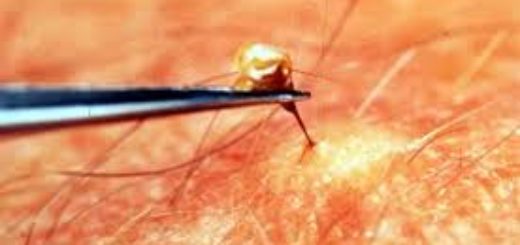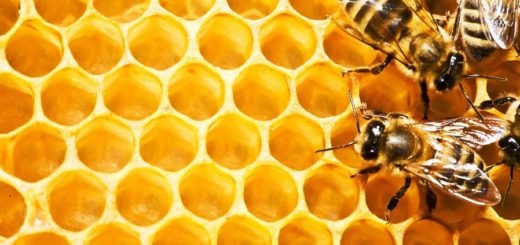European foulbrood – treatment
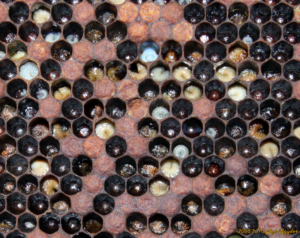 The European foulbrood disease of bees: treatment.
The European foulbrood disease of bees: treatment.
Today we consider the common features of the disease in beekeeping, its causes, diagnostic strategy and combat.
They will discuss European foulbrood.
This plague affects both the open, and sealed bee brood.
By the way, Practice knows cases of lesions drone brood – very rare.
Probability of infection higher in:
- prolonged cloudy weather;
- cooling slots;
- inadequate nutrition and other factors, negatively associated with the strength of families.
With European foul brood familiar firsthand beekeepers throughout the world. Pathogen found in any climatic zone.
It causes:
- reduced productivity of bees to honey – at least 25%;
- reducing the number of double wax;
- reducing the number of bee colonies – not less than 3 fold;
- death 40% brood.
Characteristics of the pathogen
The list of potential pathogens including Streptococcus pluton and Apis, bacillus Alva.
At the time, these organisms was considered by some authors (some authors still hold this view) secondary microflora.
If the habitat is ambrosia, the agent is capable of withstanding winter, if cells, copper – 12 months.
Streptococcus kills normal processing land in wax. In European foulbrood use such disinfectors:
- a pair of formalin;
- 4% formalin;
- 2% hinizol.
The detrimental effect of these drugs is shown in half an hour, hour 10 minutes, in accordance.
Read: Treatment of bees varroatozu. .
The spread of illness
The main agent (streptococcus pluton) – affected bdzholosim'yi, Pergamum,, copper, hives, including
structural elements (cell).
Domestic carrier of the pathogen – young insects, which in turn infected through removal of dead larvae troubled brood, cleaning his cell.
It should be noted, Streptococcus that does not affect the livelihoods of young bees.
Larvae "receive a gift" pathology of bees nursing. Healthy families can infect bees thief, drones.
The likely source of the pathogen:
- general drinkers, feeding;
- he beekeeper (because of inexperience in healthy bee colonies families using cell pathology);
- neglect veterinary and sanitary rules, example, the refusal of the periodic disinfecting clothing and equipment.
The disease
The maximum peak of European foulbrood have at the end of spring, one or two months of summer.
The closer to autumn, less signs of disease. First, the agent enters the larvae feed, then it is found in their digestive tract.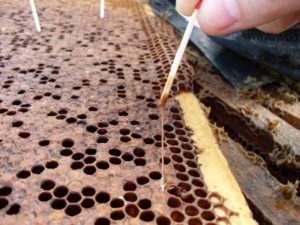
One of the features of the pathogen – rapid multiplication in the gut of the larvae.
This cause rapid destruction of the intestine and body bees.
For the first time after exposure on each side of the cell can be detected several infected larvae.
good advice: if the comb is a large concentration of insects, then the review be especially careful, as in this case, determine whether the infection is very difficult.
If you notice, that form, position larvae do not meet, This can be Alarm.
Larvae of pathology with yellow.
Read: Askosferoz bees: reason, symptoms, treatment.
Symptoms evropeysykogo gnilytsyu
The disease is accompanied by a modified form, color, provisions, consistency larvae.
Signs uninfected larvae: white with nacre; elastic body; Spent days cells; body forms a ring.
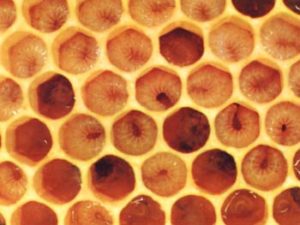 Symptoms of the problem in the early larval development of European foulbrood: yellow body; its lack of elasticity; flabbiness.
Symptoms of the problem in the early larval development of European foulbrood: yellow body; its lack of elasticity; flabbiness.
Dead larvae dry, become brown.
First issue rotten smell, after drying it disappears.
The reason for the wrong position in the cell – dying convulsions.
Usually, dead bee larvae removed.
If a second ahead, the fact that European foulbrood opportunity to tell consolidated removal of dead, burih larvae.
Diagnostics
In establishing an accurate diagnosis should be guided by signs of European foulbrood, laboratory results.
For laboratory tests as biological material used hundred pieces, which must be present as suspicious alive, and dead larvae.
A sufficient amount of other biomaterial – 100 x 150 mm. Pieces do not need hundreds wrapped in paper.
They are placed in a box and separated from all internal surfaces of containers using wooden planks.
Each sample is accompanied:
- note, comprising a number bdzholosim'yi, from which the sample was taken;
- sheet, which provides information on the name of the beekeeping sector, Name of the owner (head), date selection Biosamples, the number of dead bee colonies.
The second document signed by a veterinarian.
Treatment of European foul brood
It is important to know: determine if signs of European foul brood in the early stages, then fight it will be easier times.
In this case, beekeepers often need to replant bee. Prediction more favorable, than the reverse.
In the later stages of European foul brood should combine health measures and treatment, since otherwise the latter will be a waste of labor, funds, time.
Sanitary measures:
- remove old cells;
- family gradually transplanted in hives, passed disinfection;
- replaced insulation and other structural elements of hives.
Treatment Products
Most often sulfadimezin, antibiotics. They enrich syrups.
Alternative forms – aqueous solutions, used to spray nests.
Read: Diarrhea bees spring: causes.
Medicinal syrups
They are prepared with norsulfazolnatriya, penicillin, sultsimida, stryeptomіtsinu, tetratsiklіnu, biomitsin and other drugs.
Enrichment syrup in any of these funds will give a positive result, but still rational to combine two or three drugs.
Consider a few effective therapeutic syrups:
Recipe 1: Powdered norsulfazolnatriy (1 g) + syrup (1 l). Pre-soluble drug in 100-110 ml of water (to be hot), The resulting solution is mixed with syrup.
Every street should get on 100 ml medicine. The time between repeated feeding – 4 gained. The syrup is used to cure insect.
Recipe 2: sanazyn (1,5 g) + syrup (1 l), containing equal parts of water, sugar. The drug previously dissolved in water ratio 1 to 20.
On 1 bdzholosim'yu requires at least 1 l syrup. The period between repeated treatment courses – week. The day allowed to feed 4 times.
It is important to know: antibiotics losing their healing properties in boiling water, Therefore, their dissolution should use water, temperature is no more 32 C.
Experienced beekeepers recommend the following recipe. Penicillin (300 000 by.) + Stryeptomіtsin (200 000 by.) + Norsulfazolanatriya (1 g).
These drugs are dissolved separately and similarly infused into the solution. All streets should get on 250 ml medicine. Number of feeding on the day – 3. Break – week.
Representatives of the scientific world, working at the Institute of beekeeping, they say, that an increased effectiveness of combating disease medicinal syrups should be used in conjunction with them spraying, as the agent gets used to a strategy to combat it.
Among other things,, sprayed antibiotics and other medications in direct contact with the culprit problems.
Advice: Spraying follow in warm weather. Track, that was no big medozbiir.
WordHex of symptoms peretoplyuyutsya, Merv burned. Spray can water with dissolved antibiotics and sulfadimezin.
If the scale of the defeat little bee colonies, the problem is usually solved after 2-3 procedures.
Advice: if you have available a large apiary, then please hidropultom.
If you are an amateur beekeeper,, can be limited to a hand sprayer or spray.
They will be beneficial in many diseases.
instruments, used in spraying, pre-processed or alkali soda solution.
Below we brought recipes solutions, which often use beekeepers. Each calculated per liter of water.
Recipe 1: The water soluble penicillin and streptomycin in the ratio 500 000/200 000 from.
Recipe 2: The solution presented penicillin, sulfantronom and sodium norsulfazola. Correlation – 500 000 from. / 1 g / 1g, in accordance.
At the same time we, apparently, focus. hope, Our article will benefit you.

